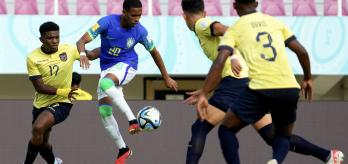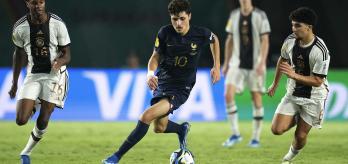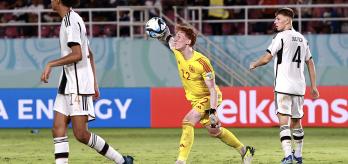Between them, goalkeepers contributed two assists in this tournament, the same total as at the 2019 U-17 World Cup, the 2023 U-20 World Cup and the senior men’s World Cup in Qatar combined. Both of those assists were kicks from hand, and it is worth noting that goalkeepers in youth tournaments kick the ball from their hands more frequently than their counterparts in senior football. In FIFA World Cup Qatar 2022™, there were just 85 kicks from the goalkeepers’ hands in a 64-match competition. By contrast, in each of the past two youth competitions (the U-17 and U-20 World Cups) there have been approximately 130 kicks from hands in a 52-match tournament.
Eliminating opposition players from the game
Quick distribution by goalkeepers is a very effective way of taking opposition players out of the game, particularly when the opponent is transitioning to defence in their final third. Goalkeepers at this U-17 World Cup certainly seemed to be aware of this, because they distributed the ball (having received it from a loose ball or as a result of their own intervention in play) while at least five opposition players were in their attacking third 40 more times in 2022 than in 2019. This development did not go unnoticed by the Technical Study Group, as Julio González underlines:
“As soon as the goalkeepers had the ball, they were looking to see where the space and opportunities were. At times, the goalkeepers were the most important players on the transitions to attack and demonstrated real intelligence in how and when they distributed the ball. Their involvement in attacking play was notable in this competition.”
Utilising the long ball
In addition, goalkeepers delivered a particularly high number of accurate long balls from their hands, suggesting that their teams had spotted the potential of long kicks to create chances and had worked on them in training.
As former Switzerland international goalkeeper Pascal Zuberbühler explains, “The vision and game awareness of the goalkeepers, in addition to the speed and effectiveness of the decisions to kick long, indicates that this was practiced by teams when preparing for this competition. Goalkeepers had real intent to restart the game quickly from transitions to attack, including when they received the ball from ball-boys and ball-girls. Forward players were smart in their positioning, isolating certain defenders in 1v1s even when the opposition defence had numerical supremacy.”
The first clip below shows a great example of an attempt at goal following quick distribution by Senegal goalkeeper Serigne Diouf (1). When he receives the ball, France have five players in their final third, while their rest defence has 3:1 numerical superiority at the halfway line. However, the attacking runs (highlighted in the image below) of Senegal’s two wide players mean that if the goalkeeper can deliver the ball long here, Senegal will be 3v3 against the defence. Diouf goes on to do exactly that; his kick goes in behind France’s defensive line and leads to a dangerous attempt at goal that demands a big save by Paul Argney.
In the second clip, Iran goalkeeper Arsha Shakouri (1) picks up the ball after a Brazilian attack. He immediately sees the run by Kasra Taheri (10) and kicks long, giving his team-mate the advantage in a 1v1 situation against a recovering defender. Taheri hits his shot first time and drills the ball through the goalkeeper’s legs to level the score at 2-2. Taheri would go on to provide the assist for Esmaeil Gholizadeh’s (7) shock winner a short time later.
The final clip comes from Uzbekistan’s group-stage draw with Spain. Here, Uzbek goalkeeper Muhammadyusuf Sobirov (21) recognises where the space is and exploits it using a long throw. While the goal was ruled out for offside, that takes nothing away from Sobirov’s quick distribution, which is a great example of how goalkeepers were assessing the scenarios in front of them and using their awareness to start fast counter-attacks.
SUMMARY
In this tournament, goalkeepers showed an increased awareness of space and how to exploit it. This helped them to make more of an impact in attack, specifically by initiating dangerous counter-attacks using quick distribution. Goalkeepers who could read the game quickly combined with outfield players making opportune forward runs to allow teams to take multiple opposition players out of the game with long balls launched directly into the opposition half. This ploy was particularly dangerous when it allowed teams to get the ball in behind the defensive line, not least because it meant forwards could run onto the ball while the defenders trying to stop them were back-pedalling towards their own goal. These types of attacks also brought an element of unpredictability and successfully destabilised rest defences, even when the defenders had numerical superiority as the goalkeepers released the ball.
All in all, this tournament was indicative of the continuing trend towards integrating goalkeepers into their teams as an eleventh outfielder – one capable of playing a key role in attack as well as defence.









